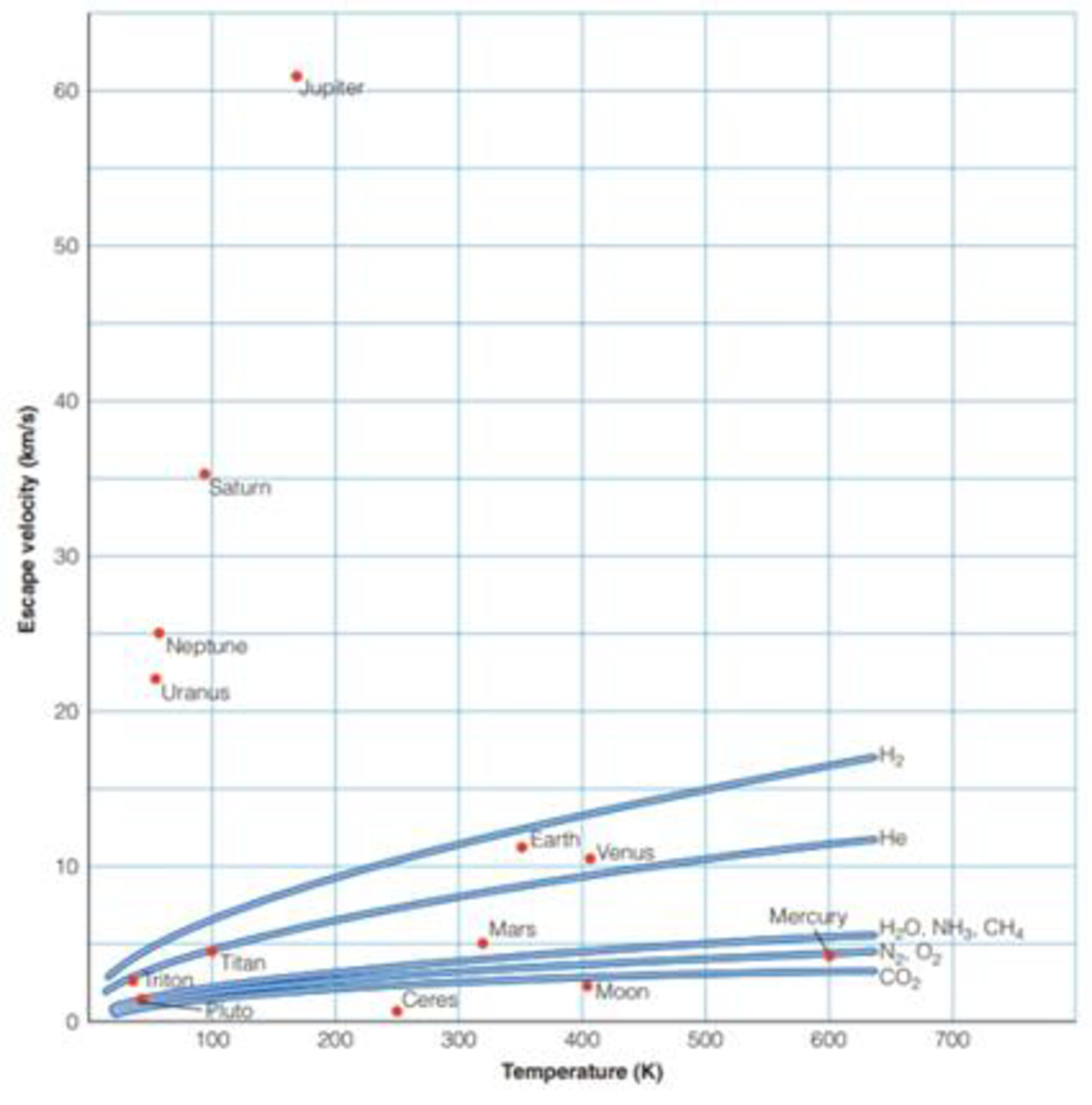
Foundations of Astronomy (MindTap Course List)
14th Edition
ISBN: 9781337399920
Author: Michael A. Seeds, Dana Backman
Publisher: Cengage Learning
expand_more
expand_more
format_list_bulleted
Textbook Question
Chapter 21, Problem 3LTL
Look at Figure 21-11. Which molecule(s) can escape from Earth’s gravity? From Mars? From Venus?

Figure 21-11 Loss of atmospheric gases. Dots represent the escape velocity and temperature of various Solar System bodies. The lines represent the typical highest velocities of molecules of various masses. The Jovian planets have high escape velocities and can hold onto even the lowest-mass molecules. Mars can hold only the more massive molecules, and the Moon has such a low escape velocity that even massive molecules can escape.
Expert Solution & Answer
Want to see the full answer?
Check out a sample textbook solution
Students have asked these similar questions
What fuel economy should be expected from a gasoline powered car that encounters a total of 443N of resistive forces while driving down the road? (Those forces are from air drag, rolling resistance and bearing losses.) Assume a 30% thermodynamic efficiency.
No chatgpt pls will upvote
12. What is the angle between two unit vectors if their dot product is 0.5?
Chapter 21 Solutions
Foundations of Astronomy (MindTap Course List)
Ch. 21 - Describe four ways Venus is similar to Earth...Ch. 21 - Why might you expect that Venuss surface...Ch. 21 - Describe and explain changes in Venuss surface...Ch. 21 - Describe sources and sinks of CO2, if any, on...Ch. 21 - Does Venuss surface experience meteorite impacts...Ch. 21 - Describe evidence of crustal movement (horizontal...Ch. 21 - Why isnt the crust of Venus broken into mobile...Ch. 21 - Do either Venus or Mars have composite volcanoes?...Ch. 21 - What evidence can you give that Venus once had...Ch. 21 - What evidence shows that Venus has been resurfaced...
Ch. 21 - Describe four ways Mars is similar to Earth today....Ch. 21 - How are todays atmospheres of Venus and Mars...Ch. 21 - Where is the oxygen on Mars today? How do you...Ch. 21 - Why doesnt Mars have folded mountain ranges like...Ch. 21 - Why isnt the crust of Mars broken into mobile...Ch. 21 - What were the canals on Mars eventually found to...Ch. 21 - How can planetary scientists estimate the ages of...Ch. 21 - Propose an explanation for the nearly pure CO2...Ch. 21 - Prob. 19RQCh. 21 - Describe sources and sinks of CO2, if any, on Mars...Ch. 21 - Does Marss surface experience any meteorite...Ch. 21 - Describe evidence of crustal movement (horizontal...Ch. 21 - What surface features on Mars today indicate that...Ch. 21 - Why are Phobos and Deimos non-spherical? Why is...Ch. 21 - How are a weather radar map and an image of a...Ch. 21 - Atmospheric jet streams on Venus travel at about...Ch. 21 - How long would radio signals take to travel from...Ch. 21 - What is the maximum angular diameter of Venus as...Ch. 21 - The Pioneer Venus orbiter circled Venus with a...Ch. 21 - Calculate the velocity of Venus as it orbits the...Ch. 21 - Prob. 6PCh. 21 - If the Magellan spacecraft transmitted radio...Ch. 21 - Prob. 8PCh. 21 - What is the angular size of Phobos observed from...Ch. 21 - Prob. 10PCh. 21 - Prob. 11PCh. 21 - Deimos is about 13 km in diameter and has a...Ch. 21 - Prob. 1SOPCh. 21 - Mercury averages only 0.39 AU from the Sun, Venus...Ch. 21 - The radius of Mars is about 3400 km, and its moons...Ch. 21 - Look at Figure 21-1. Compare temperature profiles...Ch. 21 - Look at the map of the Hawaiian chain of islands...Ch. 21 - Look at Figure 21-11. Which molecule(s) can escape...Ch. 21 - Volcano Sif Mons on Venus is shown in this radar...Ch. 21 - Olympus Mons on Mars is an enormous volcano. In...
Knowledge Booster
Learn more about
Need a deep-dive on the concept behind this application? Look no further. Learn more about this topic, physics and related others by exploring similar questions and additional content below.Similar questions
- If the car in the previous problem increases its power output by 10% (by pressing the gas pedal farther down), at what rate will the car accelerate? Hint: Consider the net force. In the previous problem the power was 31.8kWarrow_forwardWhat power is required (at the wheels) for a 1400 kg automobile to climb a 4% grade at a constant speed 30 m/s while it is opposed by drag and rolling resistance forces totaling 500 N?arrow_forwardNo chatgpt pls will upvotearrow_forward
- As a box is lifted against gravity and placed on a shelf, how does the work done by the lifter compare with the work done by gravity? What is the net work done on the box? What does this imply about its change in kinetic energy? Use definitions and mathematics from this chapter to answer these questions.arrow_forwardAs I carry a box up a flight of stairs, am I doing positive work or negative work on the box? Provide a mathematical explanation.arrow_forwardAs a ball falls under the influence of gravity, does gravity do positive work or negative work? Provide a mathematical explanation.arrow_forward
- Under what circumstances is it bad to describe kinetic energy as k = 1/2mv^2arrow_forwardNo chatgpt pls will upvotearrow_forwardAir temperature of 37 °C increases swimming pool temperature of 2.55 °C. What is the fraction of the water in the pool must evaporate during this time to carry enough energy to keep the temperature of the pool constant? 4186 J/(kg°C) = specific heat of water 2,430,000 (2.43 x 106) J/kg = latent heat of vaporization for the water in the pool.arrow_forward
- The iceberg requires 7.4 x 1020 Joules of energy to melt it completely. It absorbs energy from the Sun at a constant average rate of 88 Watts/m2. The total surface area of iceberg exposed to the sunlight is 12 billion (1.2 x 1010) square meters. How long will it take for sunlight to melt the entire iceberg in yearsarrow_forward1.0 kg block of ice to melt in the kitchen. The temperature in the kitchen is 31 °C. The ice starts out at 0 °C and takes an hour to melt and reach the same temperature as the surrounding room (31 °C). How much heat does the 1.0 kg of ice/water absorb from the room as it melts and heats up to 31 °C in Joules absorbed? Latent heat of fusion for water/ice is 334,000 J/kg Specific heat of water is 4186 J/kg°Carrow_forward5.84 If the coefficient of static friction between a table and a uni- form, massive rope is μ, what fraction of the rope can hang over the edge of the table without the rope sliding? 5.97 Block A, with weight Figure P5.97 3w, slides down an inclined plane S of slope angle 36.9° at a constant speed while plank B, with weight w, rests on top of A. The plank is attached by a cord to the wall (Fig. P5.97). (a) Draw a diagram of all the forces acting on block A. (b) If the coefficient of kinetic friction is the same between A and B and between S and A, determine its value. 36.9° 1arrow_forward
arrow_back_ios
SEE MORE QUESTIONS
arrow_forward_ios
Recommended textbooks for you
 Foundations of Astronomy (MindTap Course List)PhysicsISBN:9781337399920Author:Michael A. Seeds, Dana BackmanPublisher:Cengage Learning
Foundations of Astronomy (MindTap Course List)PhysicsISBN:9781337399920Author:Michael A. Seeds, Dana BackmanPublisher:Cengage Learning

 Horizons: Exploring the Universe (MindTap Course ...PhysicsISBN:9781305960961Author:Michael A. Seeds, Dana BackmanPublisher:Cengage Learning
Horizons: Exploring the Universe (MindTap Course ...PhysicsISBN:9781305960961Author:Michael A. Seeds, Dana BackmanPublisher:Cengage Learning AstronomyPhysicsISBN:9781938168284Author:Andrew Fraknoi; David Morrison; Sidney C. WolffPublisher:OpenStax
AstronomyPhysicsISBN:9781938168284Author:Andrew Fraknoi; David Morrison; Sidney C. WolffPublisher:OpenStax An Introduction to Physical SciencePhysicsISBN:9781305079137Author:James Shipman, Jerry D. Wilson, Charles A. Higgins, Omar TorresPublisher:Cengage Learning
An Introduction to Physical SciencePhysicsISBN:9781305079137Author:James Shipman, Jerry D. Wilson, Charles A. Higgins, Omar TorresPublisher:Cengage Learning

Foundations of Astronomy (MindTap Course List)
Physics
ISBN:9781337399920
Author:Michael A. Seeds, Dana Backman
Publisher:Cengage Learning



Horizons: Exploring the Universe (MindTap Course ...
Physics
ISBN:9781305960961
Author:Michael A. Seeds, Dana Backman
Publisher:Cengage Learning

Astronomy
Physics
ISBN:9781938168284
Author:Andrew Fraknoi; David Morrison; Sidney C. Wolff
Publisher:OpenStax

An Introduction to Physical Science
Physics
ISBN:9781305079137
Author:James Shipman, Jerry D. Wilson, Charles A. Higgins, Omar Torres
Publisher:Cengage Learning
Kepler's Three Laws Explained; Author: PhysicsHigh;https://www.youtube.com/watch?v=kyR6EO_RMKE;License: Standard YouTube License, CC-BY